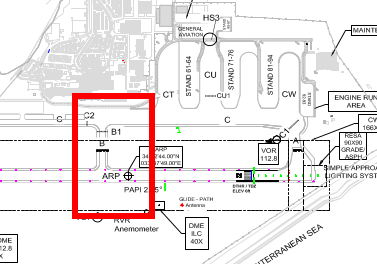


PART 2 LARNAKA AIRPORT
2.1 FREQUENCIES
| Service |
Frequency |
| Tower/Approach Control | 130.2 121.2MHz (main), 121.2 130.2 MHz (standby) |
| Ground Control | 119.4 MHz (main), 121.9 MHz (standby) |
| ATIS | 126.55 MHz |
| Emergency | 121.5 MHz |
| LCA VOR/DME | 112.8 MHz |
| LCA NDB | 432 KHz |
2.2 LOCAL RESTRICTIONS
- Standard circuit pattern RWY22 left-hand and RWY04 right-hand.
- Aircraft shall not overfly the terminal buildings, airport fuel facilities and apron areas.
- For the purpose of reducing bird scaring and the possibility of subsequent aircraft bird-strike occurrences, except in cases of urgency, aircraft must not operate over the salt lakes below 1000 FT.
- Not more than two
light aircraft are permitted to conduct circuitoperations training.
- Execution of special circuit training maneuvers, such as simulated engine failure after take-off, low-pass, bad weather circuit or glide approach, are subject to ATC approval. Go around for training purposes may be flown without prior ATC approval, however, the instructor should notify ATC immediately after initiating the procedure.
- Aircraft should enter MARKI TRAINING AREA via SIA and exit via ALAMPRA.
- Aircraft should enter LIMASSOL TRAINING AREA via North of DIPOTAMOS DAM and exit via South of DIPOTAMOS DAM.
- Unless otherwise instructed by ATC, aircraft exiting MARKI TRAINING AREA should follow the MARKI DIRECT ROUTE (ALAMPRA – KALO CHORIO).
- When LCTRA 06 (KALO CHORIO Temporary Reserved Area) is active, the leg KALO CHORIO – MOSFILOTI and vice versa shall be flown north of the road, and the leg KLAVDIA – DIPOTAMOS DAM of the DIRECT LIMASSOL ROUTE shall be flown south of KLAVDIA and north of the highway.
- ATC may apply local restrictions during periods of increased traffic or for any other operational reasons as deemed necessary.
- For separation purposes within the aerodrome traffic zone (ATZ class B airspace) with other VFR aircraft operating over the SALT LAKE, departing aircraft RWY22 may be cleared to proceed initially KALO CHORIO roundabout and avoid overflying the SALT LAKE, until leaving the ATZ. Reversely, for RWY04, departing aircraft may be cleared to proceed initially to RIZOELIA roundabout and then join the standard route.
2.3 GROUND PROCEDURES
- Pilots shall contact Ground Control for start-up clearance, reporting parking position and intentions as per filed flight plan.
- For taxi-in or taxi-out the General Aviation Apron 2, taxilane CU shall be used as per ATC taxi instructions.
- Pilots shall exercise caution and maintain lookout for vehicular movements when crossing the CU service road.
- Pilots may be instructed to hold at the intermediate holding point CU1, located at the intersection of CU and taxiway C, and displayed by surface marking only, to give way to other aircraft taxing via taxiway C.
- No light aircraft movements are allowed via taxilane CU while aircraft on stands 61-64 perform start-up or taxi.
- Unless otherwise instructed by ATC, when RWY04 in-use, departing light aircraft taxi to runway holding point via taxiway D, and arriving aircraft vacate runway via taxiway B to hold at B1, clear of taxiway C.
- Unless otherwise instructed by ATC, when RWY22 in-use, departing light aircraft taxi to runway holding point via taxiway B, and arriving aircraft vacate runway via taxiway D to hold at D1, clear of taxiway C.
- Arriving aircraft shall report to ATC when parked and shutting down.
2.4 RADIO COMMUNICATION FAILURE PROCEDURES
The aircraft shall attempt to establish communications with the appropriate
ATS unit using all available means. In addition, the aircraft, when forming part of the aerodrome traffic at a controlled aerodrome, shall keep a watch for such instructions as may be issued by visual signals.
The procedures to be followed when
VFR traffic experiences radio communication failure at LCLK are described below:
- Aircraft northwest LCLK
- Set transponder A7600.
- Arrive and orbit over the SALT LAKE maintaining last assigned altitude.
- Find out the runway in use by observing the windsock and the aerodrome traffic.
- Descend to 1000 FT and continue orbiting abeam the Control Tower.
- Look out for light signals from the Control Tower.
- Rock the wings as acknowledgement when observing the signal, and if receiving,
GREEN FLASHES: return for landing right downwind RWY22 or left downwind RWY04.
STEADY GREEN: cleared to land.
STEADY RED: continue circling over the SALT LAKE and observe light signals.
- Aircraft south/east LCLK over the sea
- Set transponder A7600.
- Arrive and orbit on downwind abeam the Control Tower maintaining last assigned altitude.
- Find out the runway in use by observing the windsock and the aerodrome traffic.
- Descend to 1000 FT and continue orbiting abeam the Control Tower.
- Look out for light signals from the Control Tower.
- Rock the wings as acknowledgement when observing the signal, and if receiving,
GREEN FLASHES: return for landing left downwind RWY22 or right downwind RWY04.
STEADY GREEN: cleared to land.
STEADY RED: continue circling on downwind and observe light signals.
2.5 GO AROUND
In case of go-around, aircraft shall climb 1000 FT, join the standard circuit pattern and contact ATC.
If go-around is executed due to loss of radio communication, aircraft shall climb 1000 FT, join the standard circuit pattern, and follow the
RCF procedure.


